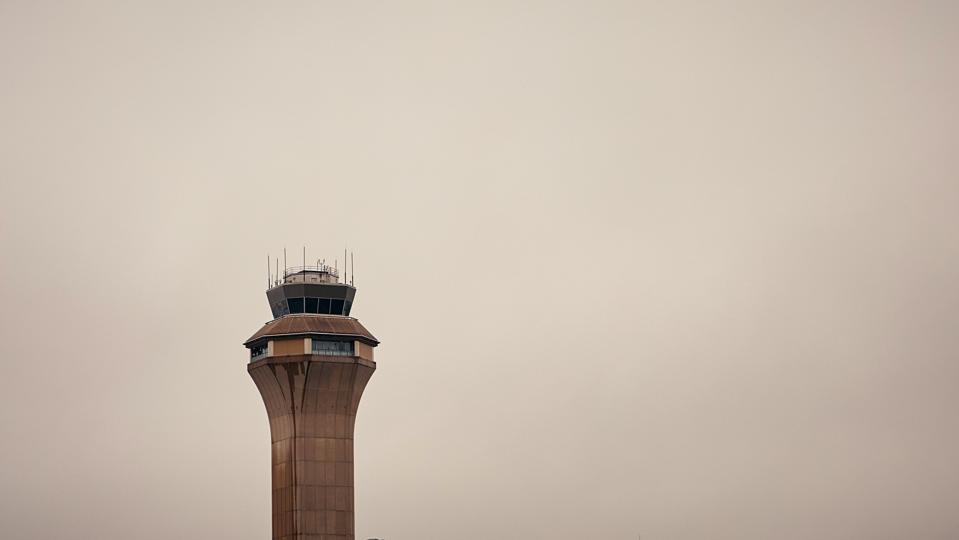Topline
The communications breakdown that sparked the crisis at New Jersey’s Newark Liberty International Airport 10 days ago wasn’t the first time air traffic controllers have lost radio contact with pilots, according to news reports–and the fallout is still impacting travelers.
Key Facts
Since April 28–when air traffic controllers lost temporary radio contact with a United plane–travelers at Newark airport have experienced long delays, often stretching several hours, as the FAA manages with fewer air traffic controllers following the incident.
Air traffic controllers guiding planes into Newark airport have lost radar contact with pilots “at least eight or nine times in recent months” and on at least two other occasions since August, a veteran controller told NBC News Tuesday.
Audio recorded by LiveATC.net from April 28 reveals a female pilot of United flight 1951 making five attempts over a period of 30 seconds to radio the tower as the plane approached Newark Liberty International Airport—leaving another pilot asking, “Approach, are you there?”
About a minute after the tower connected with that pilot of United flight 1951, the tower told United flight 674 enroute from Charleston, “we lost our radar.”
Key Background
Department of Transportation Secretary Sean Duffy blamed old technology for the communications breakdown on April 28, saying on X that he would be “announcing a plan next week to build an all-new air traffic control system.” Duffy has repeatedly said “the last administration ignored” the problem, but the Federal Aviation Administration’s outdated technology has been a known issue, and the subject of many Congressional hearings, for more than a decade–with little improvement during the tenures of Presidents Obama, Trump in his first term, or Biden.
What Happened At Newark Airport On April 28?
The problem originated in Philadelphia. On Monday, April 28, air traffic controllers in a terminal radar approach control tower (TRACON) at Philadelphia International Airport responsible for separating and sequencing aircraft in and out of Newark Airport “temporarily lost radar and communications with the aircraft under their control, unable to see, hear, or talk to them,” according to a statement provided to Forbes by the National Air Traffic Controllers Association (NATCA), the union representing the country’s 10,400 air traffic controllers. Audio confirmed that the controllers lost radio contact with a United Airlines plane for approximately 30 seconds.
Did Air Traffic Controllers Really “walk Off The Job” After The Incident?
In a May 2 letter to customers, United Airlines CEO Scott Kirby wrote that “over 20% of the FAA controllers for [Newark]
walked off the job” following the incident. But the FAA clarified in a statement that “some controllers at the Philadelphia TRACON who work Newark arrivals and departures have taken time off to recover from the stress of multiple recent outages.” A spokesperson for the air traffic controllers’ union told Forbes those ATCs were put on medical leave due to trauma. “Due to the event, the controllers took absence under the Federal Employees Compensation Act. This program covers all federal employees that are physically injured or experience a traumatic event on the job,” according to the NATCA’s statement. Neither FAA nor NATCA would say how many controllers were on trauma leave.
What Does This Mean For Travelers?
The shortage of controllers has caused hundreds of delayed and canceled flights at Newark Airport over the past week. On Monday, for example, Newark had 424 delayed flights in and out of the airport and 160 cancelled flights, according to flight tracking website FlightAware. As of Wednesday morning, there are 25 delayed flights in and out of Newark and 84 cancellations.
How Are Airlines Managing At Newark Airport?
Since last weekend, United has cut 35 roundtrip flights per day from its Newark schedule. Delta Air Lines, which has roughly 30 daily departures from Newark, told Forbes that operational impacts for flights to the New Jersey airport have been “minimal” and that passengers encountering a cancellation at Newark are automatically rebooked to the next best available itinerary, which could include other New York City hubs at LaGuardia and JFK.
Tangent
Along with outdated technology, the FAA is also challenged by a decades-long shortage of air traffic controllers. In February, Duffy unveiled a plan to “supercharge” the hiring of air traffic controllers to shave “more than four months off the old process.” But it can take nearly four years to become a certified air traffic controller, including spending several months at the FAA Academy in Oklahoma City, then completing up to three years of on-the-job experience before becoming certified, according to the FAA website.

